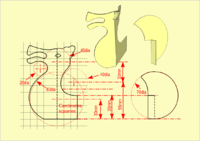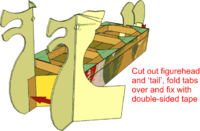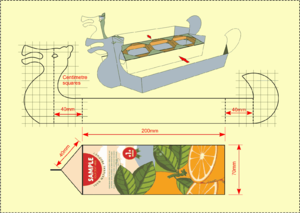Longship based on juice carton
From DT Online

Description
Longships were long elegant craft used by The Vikings to cross the North Sea, first on raiding missions and later to explore and settle in Engand, Ireland, Iceland and beyond. They were a wooden construction with a shallow Draft which meant they could be rowed up shallow rivers as well as across the sea, powered by oars and their large square woollen sail. They could also land on beaches and were light enough to be carried when necessary and tipped upside down to use as a temporary shelter.
Making a Model Longship
A model Longship can be based on a 1 litre laminated card juice carton to make the Hull.
Avantages:
- The cartons are readily available and easily cut with scissors
- When cut in two, the cartons provide ready made Hull shapes
Disadvantages:
- The 'waxy' coating on the inside, and plastic laminate on the outside, may not accept PVA glue.
Making the hull (Method 1)
The model described is based around a 1 litre fruit juice carton and 10mm square Stripwood (some dimensions will need to be adjusted if 8mm square is used).
- Two different constructions are described but start each by cutting a carton in two halves;

- Construct a Deck Frame to separate the two Hull sides using square Stripwood and reinforce with Medium Card triangles;
- A Glue Gun is a good way of fixing the Deck Frame the 'waxy' interior of the carton but, if not available, you may wish to try adding Masking Tape, or another self-adhesive paper tape, around the inside edge to provide a surface more easily glued.


- Glue the Deck Frame in between the two hull sides, as shown;
- Hold in place with Pegs or Clips if needed and leave to dry;
- The Figure Head and 'Tail' can be kept simple or used as a design activity in itself - the object is to create a 'Dragon Head profile and a matching 'Tail' end of the Longship;
- Some suggested sizes are shown opposite but these are only for guidance (click on image to enlarge);
- Cut two of each out of Medium Card;
- Fold the tabs over as indicated and fix to the carton using Double-Sided Tape
- The completed hull can now be painted but mix water-based paints with PVA glue to help it stick to the 'shiny' surface of the carton (alternatively and if allowed, use a model maker's enamel paint).
Making the hull (Method 2)
- Construct a Deck Frame and glue in between the two hull sides, as for Method 1;
- Hold in place with Pegs or Clips if needed;


- Make two triangles, with glue tabs, to cover the space between the Deck Frame and the top of the carton
- Fix one to the bow and one to the stern using Double-Sided Tape
- Cut out two Hull sides based on the drawing shown (click on image to enlarge);
- Crease along the dotted lines and fold as indicated;
- Double-Sided Tape or using a Glue Gun are both good ways of fixing to the 'shiny' outside surface of the carton;
- Glue the two sides in place and to each other to complete the Hull ready for painting.
Completing the Longship
- Add a Mast by 'stepping' a length of Dowel into a MDF or Ply Disc and glue to the Deck Frame or the bottom of the Hull;
- Add a Main Spar by fixing a length of Dowel across the top of the Mast either by lashing with string and glue or by cutting two holes at right angles into a short length of PVC Tubing;
- Make a Sail out of Thin Card, paint as required and glue along the Main Spar;
- Design and paint Viking Shields on MDF, Ply or Card Discs and glue along the sides of the Hull;
- Add Oars made by squashing the end of Art Straws or Drinking Straws.
Notes:
- MDF Discs which are pre-drilled are most useful if available, otherwise this might be done as preparation before using with younger children - alternatively a Hand Drill Stand could be used (if neccessary, adults or older children can cut them out of strips of MDF or Ply using a Holesaw).
- Dowels 4mm, 5mm, and 6mm are useful sizes for axles.
- Florist Wire is easily bent into shape whereas stiff wire, such as Brass Brazing Rod, is more suitable for connecting rods.



















